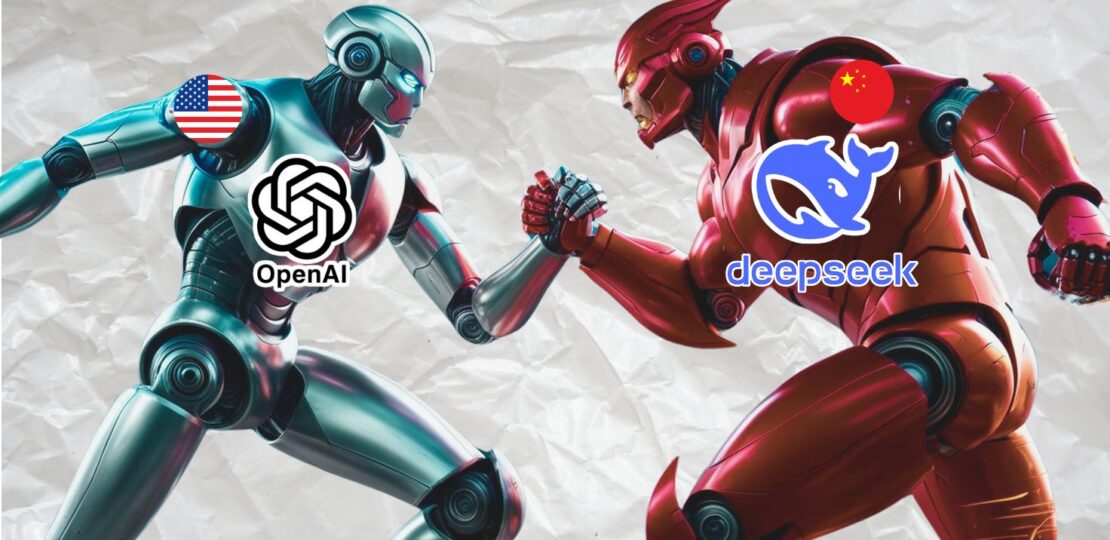DeepSeek: The Chinese Innovation That Is Redrawing the Map of Artificial Intelligence
January 29, 2025 | by Felipe Matos

The global artificial intelligence (AI) landscape is being radically transformed by the rise of DeepSeek, a Chinese startup that creates a language model of the same name. In a short period of time, DeepSeek has not only surpassed ChatGPT in the number of downloads in the US, but also caused a precipitous drop of US$1 trillion in the market value of American tech giants. This seismic shift raises crucial questions about the future of AI and China’s role in this new landscape.
Efficiency and Accessibility: The Pillars of DeepSeek’s Rise
In contrast to the billion-dollar investments in AI from companies like Google and Microsoft, DeepSeek has taken a different path, marked by efficiency and accessibility. With a modest investment of $6 million, the Chinese startup has built a language model that is on par with, and in some ways surpasses, American models.
Join my WhatsApp groups! Daily updates with the most relevant news in the AI world and a vibrant community!
- AI for Business: focused on business and strategy.
- AI Builders: with a more technical and hands-on approach.
The key to this achievement lies in streamlining the development process. DeepSeek uses innovative algorithms that enable AI models to be trained with less data and computational power, significantly reducing development costs and time. Furthermore, the decision to open source its models demonstrates a commitment to the democratization of AI and open collaboration.
Uncovering the Black Box: Innovative Techniques Behind DeepSeek
DeepSeek stands out for its innovative technical approach, combining different strategies to achieve high performance at low cost:
- Transfer Learning: Imagine a student who, when learning a new language, uses the knowledge they already have of their native language. It’s as if they take the grammatical structures and vocabulary they already know and adapt them to the new language. Transfer learning works in a similar way, reusing the knowledge of pre-trained AI models to accelerate the learning of new tasks.
- Self-supervised learning: Think of a child learning to ride a bike. They don’t need a manual with detailed instructions. Through observation, trial and error, they gradually learn to balance and pedal. Self-supervised learning allows AI to learn in a similar way, exploring unlabeled data and discovering patterns on its own.
- Knowledge Distillation: Imagine a seasoned teacher imparting his or her knowledge to a young learner. The teacher condenses years of experience into concise, effective lessons. Knowledge distillation in AI works in a similar way, transferring knowledge from a complex model to a smaller, more efficient model.
- Quantization: Think of a sculptor who transforms a rough block of marble into a refined work of art. Quantization in AI is like a polishing process, removing unnecessary information and reducing the complexity of the model, making it lighter and more agile.
The Seismic Impact and the Future of AI:
The rise of DeepSeek is reshaping the balance of power in the global AI market. The sharp drop in the market value of US big tech companies highlights the growing competitiveness in the sector and the need to adapt to this new reality.
DeepSeek’s success signals a paradigm shift in AI, with a focus on more efficient, accessible and collaborative models. China is emerging as a driving force in this process, challenging American hegemony and driving innovation on a global scale.
In a world that is increasingly dependent on AI, accessibility and open collaboration are essential to ensuring that the benefits of this technology reach all sectors of society. DeepSeek, with its disruptive approach, is paving the way for a more democratic and inclusive future of AI.
✨Did you like it? You can sign up to receive 10K Digital's newsletters in your email, curated by me, with the best content about AI and business.
➡️ Join the 10K Community here
RELATED POSTS
View all



